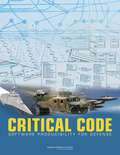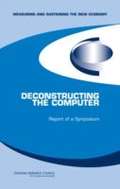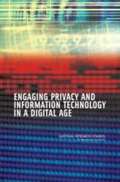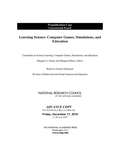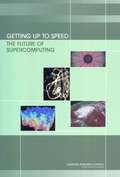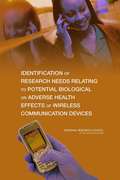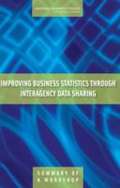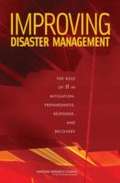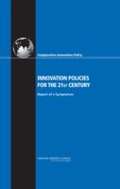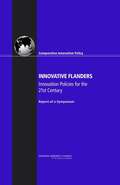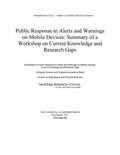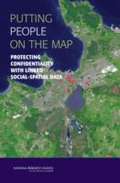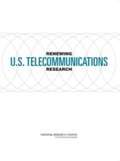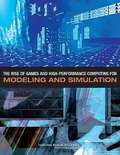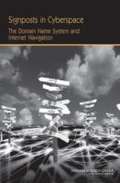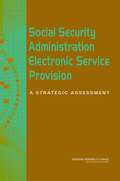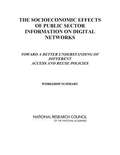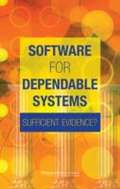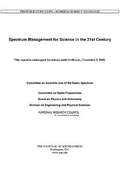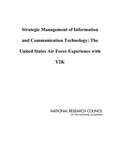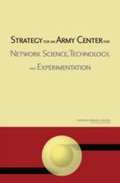- Table View
- List View
Critical Code: Software Producibility for Defense
by National Research Council of the National AcademiesCritical Code contemplates Department of Defense (DoD) needs and priorities for software research and suggests a research agenda and related actions. Building on two prior books--Summary of a Workshop on Software Intensive Systems and Uncertainty at Scale and Preliminary Observations on DoD Software Research Needs and Priorities--the present volume assesses the nature of the national investment in software research and, in particular, considers ways to revitalize the knowledge base needed to design, produce, and employ software-intensive systems for tomorrow's defense needs. Critical Code discusses four sets of questions: To what extent is software capability significant for the DoD? Is it becoming more or less significant and strategic in systems development? Will the advances in software producibility needed by the DoD emerge unaided from industry at a pace sufficient to meet evolving defense requirements? What are the opportunities for the DoD to make more effective use of emerging technology to improve software capability and software producibility? In which technology areas should the DoD invest in research to advance defense software capability and producibility?
Deconstructing the Computer: Report of a Symposium
by National Research Council of the National AcademiesStarting in the mid 1990s, the United States economy experienced an unprecedented upsurge in economic productivity. Rapid technological change in communications, computing, and information management continue to promise further gains in productivity, a phenomenon often referred to as the New Economy. To better understand this phenomenon, the National Academies Board on Science, Technology, and Economic Policy (STEP) has convened a series of workshops and commissioned papers on Measuring and Sustaining the New Economy. This major workshop, entitled Deconstructing the Computer, brought together leading industrialists and academic researchers to explore the contribution of the different components of computers to improved price-performance and quality of information systems. The objective was to help understand the sources of the remarkable growth of American productivity in the 1990s, the relative contributions of computers and their underlying components, and the evolution and future contributions of the technologies supporting this positive economic performance.
Engaging Privacy And Information Technology In A Digital Age
by National Research Council of the National AcademiesPrivacy is a growing concern in the United States and around the world. The spread of the Internet and the seemingly boundaryless options for collecting, saving, sharing, and comparing information trigger consumer worries. Online practices of business and government agencies may present new ways to compromise privacy, and e-commerce and technologies that make a wide range of personal information available to anyone with a Web browser only begin to hint at the possibilities for inappropriate or unwarranted intrusion into our personal lives. Engaging Privacy and Information Technology in a Digital Age presents a comprehensive and multidisciplinary examination of privacy in the information age. It explores such important concepts as how the threats to privacy evolving, how can privacy be protected and how society can balance the interests of individuals, businesses and government in ways that promote privacy reasonably and effectively? This book seeks to raise awareness of the web of connectedness among the actions one takes and the privacy policies that are enacted, and provides a variety of tools and concepts with which debates over privacy can be more fruitfully engaged. Engaging Privacy and Information Technology in a Digital Age focuses on three major components affecting notions, perceptions, and expectations of privacy: technological change, societal shifts, and circumstantial discontinuities. This book will be of special interest to anyone interested in understanding why privacy issues are often so intractable.
FORCEnet: IMPLEMENTATION STRATEGY
by National Research Council of the National AcademiesThe National Academies Press (NAP)--publisher for the National Academies--publishes more than 200 books a year offering the most authoritative views, definitive information, and groundbreaking recommendations on a wide range of topics in science, engineering, and health. Our books are unique in that they are authored by the nation's leading experts in every scientific field.
The Future of Computing Performance: Game Over or Next Level?
by National Research Council of the National AcademiesThe end of dramatic exponential growth in single-processor performance marks the end of the dominance of the single microprocessor in computing. The era of sequential computing must give way to a new era in which parallelism is at the forefront. Although important scientific and engineering challenges lie ahead, this is an opportune time for innovation in programming systems and computing architectures. We have already begun to see diversity in computer designs to optimize for such considerations as power and throughput. The next generation of discoveries is likely to require advances at both the hardware and software levels of computing systems. There is no guarantee that we can make parallel computing as common and easy to use as yesterday's sequential single-processor computer systems, but unless we aggressively pursue efforts suggested by the recommendations in this book, it will be "game over" for growth in computing performance. If parallel programming and related software efforts fail to become widespread, the development of exciting new applications that drive the computer industry will stall; if such innovation stalls, many other parts of the economy will follow suit. The Future of Computing Performance describes the factors that have led to the future limitations on growth for single processors that are based on complementary metal oxide semiconductor (CMOS) technology. It explores challenges inherent in parallel computing and architecture, including ever-increasing power consumption and the escalated requirements for heat dissipation. The book delineates a research, practice, and education agenda to help overcome these challenges. The Future of Computing Performance will guide researchers, manufacturers, and information technology professionals in the right direction for sustainable growth in computer performance, so that we may all enjoy the next level of benefits to society.
Getting Up To Speed The Future Of Supercomputing
by National Research Council of the National AcademiesSupercomputers play a significant and growing role in a variety of areas important to the nation. They are used to address challenging science and technology problems. In recent years, however, progress in supercomputing in the United States has slowed. The development of the Earth Simulator supercomputer by Japan that the United States could lose its competitive advantage and, more importantly, the national competence needed to achieve national goals. In the wake of this development, the Department of Energy asked the NRC to assess the state of U. S. supercomputing capabilities and relevant R&D. Subsequently, the Senate directed DOE in S. Rpt. 107-220 to ask the NRC to evaluate the Advanced Simulation and Computing program of the National Nuclear Security Administration at DOE in light of the development of the Earth Simulator. This report provides an assessment of the current status of supercomputing in the United States including a review of current demand and technology, infrastructure and institutions, and international activities.
Identification Of Research Needs Relating To Potential Biological Or Adverse Health Effects Of Wireless Communication Devices
by National Research Council of the National AcademiesIn recent years there has been a rapid increase in the use of wireless communications devices and a great deal of research has been carried out to investigate possible biological or human health effects resulting from their use. The U.S. Food and Drug Administration asked the National Research Council to organize a workshop to identify research needs and gaps in knowledge in the areas of dosimetry and exposure, epidemiology, human laboratory studies, mechanisms, and animal and cell biology. The workshop did not include the evaluation of health effects or the generation of recommendations relating to how identified research needs should be met. Some needs and gaps identified at the workshop include: (1) characterization of exposures from wireless devices and RF base station antennas in juveniles, children, fetuses, and pregnant women and (2) evaluation of devices that use newer technologies (e.g., texting, web-surfing).
Improving Business Statistics Through Interagency Data Sharing: Summary Of A Workshop
by National Research Council of the National AcademiesThe National Academies Press (NAP)--publisher for the National Academies--publishes more than 200 books a year offering the most authoritative views, definitive information, and groundbreaking recommendations on a wide range of topics in science, engineering, and health. Our books are unique in that they are authored by the nation'#8217;s leading experts in every scientific field.
Improving Disaster Management: The Role Of It In Mitigation, Preparedness, Response, And Recovery
by National Research Council of the National AcademiesInformation technology (IT) has the potential to play a critical role in managing natural and human made disasters. Damage to communications infrastructure, along with other communications problems exacerbated the difficulties in carrying out response and recovery efforts following Hurricane Katrina. To assist government planning in this area, the Congress, in the E-government Act of 2002, directed the Federal Emergency Management Agency (FEMA) to request the NRC to conduct a study on the application of IT to disaster management. This report characterizes disaster management providing a framework for considering the range and nature of information and communication needs; presents a vision of the potential for IT to improve disaster management; provides an analysis of structural, organizational, and other non-technical barriers to the acquisition, adoption, and effective use of IT in disaster; and offers an outline of a research program aimed at strengthening IT-enabled capabilities for disaster management.
Innovation In Global Industries: U.s. Firms Competing In A New World
by National Research Council of the National AcademiesThe debate over offshoring of production, transfer of technological capabilities, and potential loss of U.S. competitiveness is a long-running one. Prevailing thinking is that “the world is flat”—that is, innovative capacity is spreading uniformly; as new centers of manufacturing emerge, research and development and new product development follow. Innovation in Global Industries challenges this thinking. The book, a collection of individually authored studies, examines in detail structural changes in the innovation process in 10 service as well as manufacturing industries: personal computers; semiconductors; flat-panel displays; software; lighting; biotechnology; pharmaceuticals; financial services; logistics; and venture capital. There is no doubt that overall there has been an acceleration in global sourcing of innovation and an emergence of new locations of research capacity and advanced technical skills, but the patterns are highly variable. Many industries and some firms in nearly all industries retain leading-edge capacity in the United States. However, the book concludes that is no reason for complacency about the future outlook. Innovation deserves more emphasis in firm performance measures and more sustained support in public policy. Innovation in Global Industries will be of special interest to business people and government policy makers as well as professors, students, and other researchers of economics, management, international affairs, and political science.
INNOVATION POLICIES FOR THE 21ST CENTURY: Report of a Symposium
by National Research Council of the National AcademiesTo mark the opening of a study of Comparative Innovation Policy: Best Practice for the 21st Century the Board on Science, Technology, and Economic Policy (STEP) convened a symposium providing an overview of areas to be examined in the study and topics requiring further policy attention. The event highlighted the policies and programs of leading nations and provided valuable insights into some of the common challenges of growing and supporting high-technology industry and the commercialization of public investments in R&D. This report contains a summary of the symposium proceedings and an introduction analyzing the issues and placing them in a broader policy context.
INNOVATIVE FLANDERS: Innovation Policies for the 21st Century
by National Research Council of the National AcademiesRecognizing that innovation is the key to international competitiveness in the 21st century, policymakers around the world are seeking more effective ways to translate scientific and technological knowledge into new products, processes, and businesses. They have initiated major programs, often with substantial funding, that are designed to attract, nurture, and support innovation and high-technology industries within their national economies. To help U.S. policymakers become more aware of these developments, a committee of the National Academies' Board on Science, Technology, and Economic Policy undertook a review of the goals, concept, structure, operation, funding levels, and evaluation efforts of significant innovation programs around the world. As a part of this effort, the committee identified Flanders, a region of Belgium with substantial autonomy, which is recognized for its comprehensive approach to innovation. Based on initial meetings in Washington and Brussels, and with the endorsement of Flanders Vice Minister-President Fientje Moerman, it was agreed to organize a conference that would review regional innovation policies in the context of the policies and programs of the Flanders government, and their interaction with those of the European Union. This book provides a summary of that symposium.
PREPARING FOR THE REVOLUTION: Information Technology and the Future of the Research University
by National Research Council of the National AcademiesThe rapid evolution of information technology (IT) is transforming our society and its institutions. For the most knowledge-intensive entities of all, research universities, profound IT-related challenges and opportunities will emerge in the next decade or so. Yet, there is a sense that some of the most significant issues are not well understood by academic administrators, faculty, and those who support or depend on the institution’s activities. This study identifies those information technologies likely to evolve in the near term (a decade or less) that could ultimately have a major impact on the research university. It also examines the possible implications of these technologies for the research university—its activities (learning, research, outreach) and its organization, management, and financing—and for the broader higher education enterprise. The authoring committee urges research universities and their constituents to develop new strategies to ensure that they survive and thrive in the digital age.
Protecting Individual Privacy in the Struggle Against Terrorists: A Framework for Program Assessment
by National Research Council of the National AcademiesAll U.S. agencies with counterterrorism programs that collect or "mine" personal data -- such as phone records or Web sites visited -- should be required to evaluate the programs' effectiveness, lawfulness, and impacts on privacy. A framework is offered that agencies can use to evaluate such information-based programs, both classified and unclassified. The book urges Congress to re-examine existing privacy law to assess how privacy can be protected in current and future programs and recommends that any individuals harmed by violations of privacy be given a meaningful form of redress. Two specific technologies are examined: data mining and behavioral surveillance. Regarding data mining, the book concludes that although these methods have been useful in the private sector for spotting consumer fraud, they are less helpful for counterterrorism because so little is known about what patterns indicate terrorist activity. Regarding behavioral surveillance in a counterterrorist context, the book concludes that although research and development on certain aspects of this topic are warranted, there is no scientific consensus on whether these techniques are ready for operational use at all in counterterrorism.
Public Response to Alerts and Warnings on Mobile Devices: Summary of a Workshop on Current Knowledge and Research Gaps
by National Research Council of the National AcademiesThis book presents a summary of the Workshop on Public Response to Alerts and Warnings on Mobile Devices: Current Knowledge and Research Gaps, held April 13 and 14, 2010, in Washington, D.C., under the auspices of the National Research Council's Committee on Public Response to Alerts and Warnings on Mobile Devices: Current Knowledge and Research Needs. The workshop was structured to gather inputs and insights from social science researchers, technologists, emergency management professionals, and other experts knowledgeable about how the public responds to alerts and warnings, focusing specifically on how the public responds to mobile alerting.
Putting People On The Map: Protecting Confidentiality With Linked Social-spatial Data
by National Research Council of the National AcademiesPrecise, accurate spatial information linked to social and behavioral data is revolutionizing social science by opening new questions for investigation and improving understanding of human behavior in its environmental context. At the same time, precise spatial data make it more likely that individuals can be identified, breaching the promise of confidentiality made when the data were collected. Because norms of science and government agencies favor open access to all scientific data, the tension between the benefits of open access and the risks associated with potential breach of confidentiality pose significant challenges to researchers, research sponsors, scientific institutions, and data archivists. Putting People on the Map finds that several technical approaches for making data available while limiting risk have potential, but none is adequate on its own or in combination. This book offers recommendations for education, training, research, and practice to researchers, professional societies, federal agencies, institutional review boards, and data stewards.
Renewing U.s. Telecommunications Research
by National Research Council of the National AcademiesThe modern telecommunications infrastructure—made possible by research performed over the last several decades—is an essential element of the U.S. economy. The U.S. position as a leader in telecommunications technology, however, is at risk because of the recent decline in domestic support of long-term, fundamental telecommunications research. To help understand this challenge, the National Science Foundation asked the NRC to assess the state of telecommunications research in the United States and recommend ways to halt the research decline. This report provides an examination of telecommunications research support levels, focus, and time horizon in industry, an assessment of university telecommunications research, and the implications of these findings on the health of the sector. Finally, it presents recommendations for enhancing U.S. telecommunications’ research efforts.
The Rise of Games and High-Performance Computing for Modeling and Simulation
by National Research Council of the National AcademiesThe technical and cultural boundaries between modeling, simulation, and games are increasingly blurring, providing broader access to capabilities in modeling and simulation and further credibility to game-based applications. The purpose of this study is to provide a technical assessment of Modeling, Simulation, and Games (MS&G) research and development worldwide and to identify future applications of this technology and its potential impacts on government and society. Further, this study identifies feasible applications of gaming and simulation for military systems; associated vulnerabilities of, risks to, and impacts on critical defense capabilities; and other significant indicators and warnings that can help prevent or mitigate surprises related to technology applications by those with hostile intent. Finally, this book recommends priorities for future action by appropriate departments of the intelligence community, the Department of Defense research community, and other government entities. The Rise of Games and High Performance Computing for Modeling and Simulation will serve as a useful tutorial and reference document for this particular era in the evolution of MS&G. The book also highlights a number of rising capabilities facilitated by MS&G to watch for in the coming years.
Signposts in Cyberspace: The Domain Name System and Internet Navigation
by National Research Council of the National AcademiesThe Domain Name System (DNS) enables user-friendly alphanumeric names—domain names—to be assigned to Internet sites. Many of these names have gained economic, social, and political value, leading to conflicts over their ownership, especially names containing trademarked terms. Congress, in P.L. 105-305, directed the Department of Commerce to request the NRC to perform a study of these issues. When the study was initiated, steps were already underway to address the resolution of domain name conflicts, but the continued rapid expansion of the use of the Internet had raised a number of additional policy and technical issues. Furthermore, it became clear that the introduction of search engines and other tools for Internet navigation was affecting the DNS. Consequently, the study was expanded to include policy and technical issues related to the DNS in the context of Internet navigation. This report presents the NRC’s assessment of the current state and future prospects of the DNS and Internet navigation, and its conclusions and recommendations concerning key technical and policy issues.
Social Security Administration Electronic Service Provision: A STRATEGIC ASSESSMENT
by National Research Council of the National AcademiesThe National Academies Press (NAP)--publisher for the National Academies--publishes more than 200 books a year offering the most authoritative views, definitive information, and groundbreaking recommendations on a wide range of topics in science, engineering, and health. Our books are unique in that they are authored by the nation's leading experts in every scientific field.
The Socioeconomic Effects of Public Sector Information on Digital Networks: Toward a Better Understanding of Different Access and Reuse Policies - Workshop Summary
by National Research Council of the National AcademiesWhile governments throughout the world have different approaches to how they make their public sector information (PSI) available and the terms under which the information may be reused, there appears to be a broad recognition of the importance of digital networks and PSI to the economy and to society. However, despite the huge investments in PSI and the even larger estimated effects, surprisingly little is known about the costs and benefits of different information policies on the information society and the knowledge economy. By understanding the strengths and weaknesses of the current assessment methods and their underlying criteria, it should be possible to improve and apply such tools to help rationalize the policies and to clarify the role of the internet in disseminating PSI. This in turn can help promote the efficiency and effectiveness of PSI investments and management, and to improve their downstream economic and social results. The workshop that is summarized in this volume was intended to review the state of the art in assessment methods and to improve the understanding of what is known and what needs to be known about the effects of PSI activities.
Software For Dependable Systems: Sufficient Evidence?
by National Research Council of the National AcademiesThe National Academies Press (NAP)--publisher for the National Academies--publishes more than 200 books a year offering the most authoritative views, definitive information, and groundbreaking recommendations on a wide range of topics in science, engineering, and health. Our books are unique in that they are authored by the nation's leading experts in every scientific field.
Spectrum Management for Science in the 21st Century
by National Research Council of the National AcademiesRadio observations of the cosmos are gathered by geoscientists using complex earth-orbiting satellites and ground-based equipment, and by radio astronomers using large ground-based radio telescopes. Signals from natural radio emissions are extremely weak, and the equipment used to measure them is becoming ever-more sophisticated and sensitive. The radio spectrum is also being used by radiating, or "active," services, ranging from aircraft radars to rapidly expanding consumer services such as cellular telephones and wireless internet. These valuable active services transmit radio waves and thereby potentially interfere with the receive-only, or "passive," scientific services. Transmitters for the active services create an artificial "electronic fog" which can cause confusion, and, in severe cases, totally blinds the passive receivers. Both the active and the passive services are increasing their use of the spectrum, and so the potential for interference, already strong, is also increasing. This book addresses the tension between the active services' demand for greater spectrum use and the passive users' need for quiet spectrum. The included recommendations provide a pathway for putting in place the regulatory mechanisms and associated supporting research activities necessary to meet the demands of both users.
Strategic Management of Information and Communication Technology: The United States Air Force Experience with Y2K
by National Research Council of the National AcademiesAlthough Y2K did not result in major disruptions, the event is a rich source of critical lessons for strategic management of information and communication technology (ICT), many of which apply to large organizations today. Using a case study approach, this report describes lessons learned from the response of the Air Force to Y2K and makes recommendations for managing ICT complexity, aligning organizational and ICT strategies, and minimizing risk.
Strategy For An Army Center For Network Science, Technology, And Experimentation
by National Research Council of the National AcademiesThe U.S. military has committed to a strategy of network-centric warfare. As a result, the Army has become increasingly interested in the critical role of network science. To a significant extent, this interest was stimulated by an earlier NRC report, Network Science. To build on that book, the Army asked the NRC to conduct a study to define advanced operating models and architectures for future Army laboratories and centers focused on network science, technologies, and experimentation (NSTE). The challenges resulting from base realignment and closure (BRAC) relocations of Army research, development, and engineering resources--as they affected the NSTE program--were also to be a focus of the study. This book provides a discussion of what NSTE is needed by the Army; an examination of the NSTE currently carried out by the Army; an assessment of needed infrastructure resources for Army NSTE; and an analysis of goals, models, and alternatives for an NSTE center.
